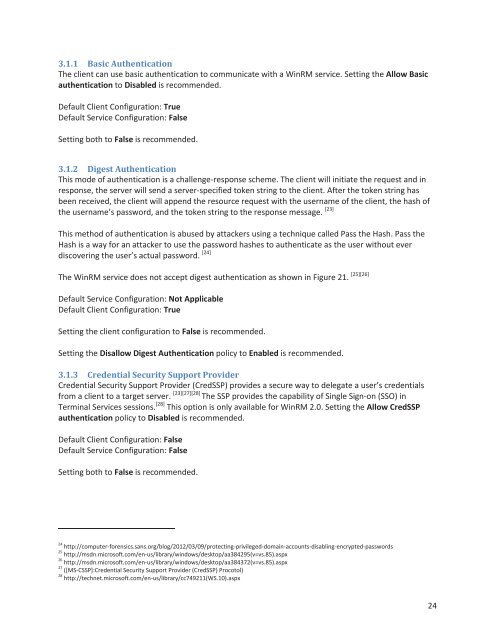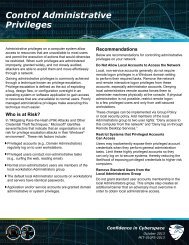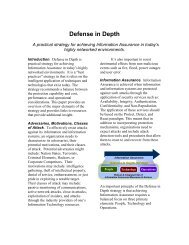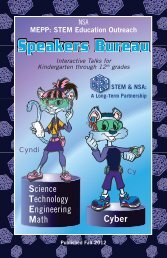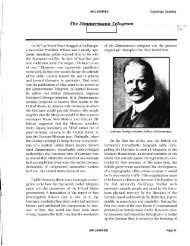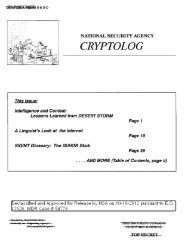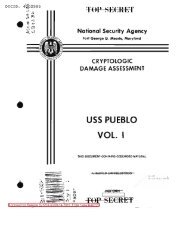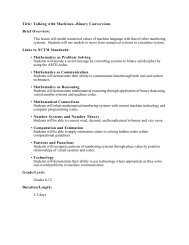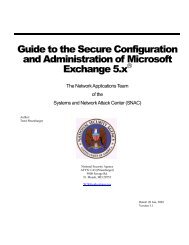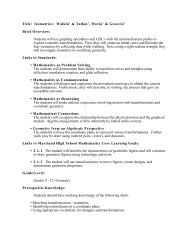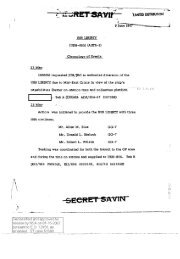Spotting the Adversary with Windows Event Log Monitoring
Spotting the Adversary with Windows Event Log Monitoring
Spotting the Adversary with Windows Event Log Monitoring
Create successful ePaper yourself
Turn your PDF publications into a flip-book with our unique Google optimized e-Paper software.
3.1.1 Basic Au<strong>the</strong>ntication<br />
The client can use basic au<strong>the</strong>ntication to communicate <strong>with</strong> a WinRM service. Setting <strong>the</strong> Allow Basic<br />
au<strong>the</strong>ntication to Disabled is recommended.<br />
Default Client Configuration: True<br />
Default Service Configuration: False<br />
Setting both to False is recommended.<br />
3.1.2 Digest Au<strong>the</strong>ntication<br />
This mode of au<strong>the</strong>ntication is a challenge-response scheme. The client will initiate <strong>the</strong> request and in<br />
response, <strong>the</strong> server will send a server-specified token string to <strong>the</strong> client. After <strong>the</strong> token string has<br />
been received, <strong>the</strong> client will append <strong>the</strong> resource request <strong>with</strong> <strong>the</strong> username of <strong>the</strong> client, <strong>the</strong> hash of<br />
<strong>the</strong> username’s password, and <strong>the</strong> token string to <strong>the</strong> response message. [23]<br />
This method of au<strong>the</strong>ntication is abused by attackers using a technique called Pass <strong>the</strong> Hash. Pass <strong>the</strong><br />
Hash is a way for an attacker to use <strong>the</strong> password hashes to au<strong>the</strong>nticate as <strong>the</strong> user <strong>with</strong>out ever<br />
discovering <strong>the</strong> user’s actual password. [24]<br />
The WinRM service does not accept digest au<strong>the</strong>ntication as shown in Figure 21. [25][26]<br />
Default Service Configuration: Not Applicable<br />
Default Client Configuration: True<br />
Setting <strong>the</strong> client configuration to False is recommended.<br />
Setting <strong>the</strong> Disallow Digest Au<strong>the</strong>ntication policy to Enabled is recommended.<br />
3.1.3 Credential Security Support Provider<br />
Credential Security Support Provider (CredSSP) provides a secure way to delegate a user’s credentials<br />
from a client to a target server. [23][27][28] The SSP provides <strong>the</strong> capability of Single Sign-on (SSO) in<br />
Terminal Services sessions. [28] This option is only available for WinRM 2.0. Setting <strong>the</strong> Allow CredSSP<br />
au<strong>the</strong>ntication policy to Disabled is recommended.<br />
Default Client Configuration: False<br />
Default Service Configuration: False<br />
Setting both to False is recommended.<br />
24 http://computer-forensics.sans.org/blog/2012/03/09/protecting-privileged-domain-accounts-disabling-encrypted-passwords<br />
25 http://msdn.microsoft.com/en-us/library/windows/desktop/aa384295(v=vs.85).aspx<br />
26 http://msdn.microsoft.com/en-us/library/windows/desktop/aa384372(v=vs.85).aspx<br />
27 ([MS-CSSP]:Credential Security Support Provider (CredSSP) Procotol)<br />
28 http://technet.microsoft.com/en-us/library/cc749211(WS.10).aspx<br />
24


